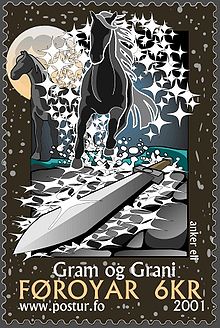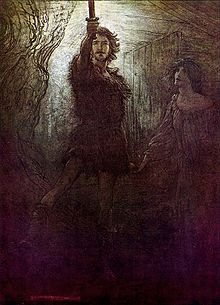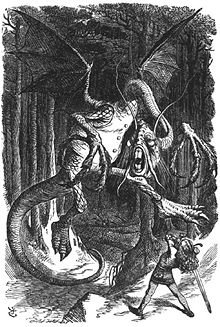- Magic sword
-
For other uses, see Magic sword (disambiguation).
The term magic sword refers to any kind of mythological or fictional sword imbued with magical power to increase its strength or grant it other supernatural qualities. The archetype originated in myth and legend, and occurs regularly in fantasy fiction.
Renowned swords appear in the folklore of every nation that used swords.[1] Sometimes the sword is ascribed no powers of its own. It is famous because it is the hero's sword, or because of its origin, as when a god gives it to the hero. Other swords keep their wielders safe or destroy their enemies.
A more localized motif is the sword that has been broken and must be reforged, commonly found in Northern Europe. Such a sword symbolizes the initial defeat and loss of honor of its wielder. Subsequent victory and the restoration of honor is achieved by reforging it, either at the wielder's hand or that of his heir.[1]
Contents
History
It is probably that the roots of the sentient weapon myths stem from ancient peoples belief that sword making and metallurgy was in fact a magical process. Through the fires of the forge (fire was also given spiritual connotations) a lump of earth was transformed into a shiny usable object that could be hammered into many shapes. Extending further from the transformation of ore into metal, the difficulty of actually obtaining a quality blade; which took intense concentration and skill added to its esoteric qualities. while any blacksmith could manufacture a knife or an axehead only a swordsmith could create a high quality sword. The secrets of doing so were jealously guarded as well as formulas for alloys.
The skill necessary to forge a balanced blade - one which is not too brittle or too soft and able to hold a usefully sharp edge - in the age before automated machines, blast furnaces, and the knowledge of molecular chemistry made the creation of a sword seem almost miraculous. A few degrees too hot or too cold within a very limited temperature range, which could only be discerned by the glowing hue of a hot billet, could make or break a sword. A lack of expertise in knowing when and how to apply carbon and flux and quench the blade could ruin weeks of work. Thus the swordsmith almost felt like he was one with his work, giving the process his complete devotion of concentration and thought. This led to the belief that he was actually imbuing the blade with an essence of his spirit. In Japan, the swordsmiths were so concerned with this belief that they would undergo purification rituals and meditation before even attempting to start a new blade, for fear that they may inadvertently create an evil sword.
It is also important to note that in antiquity; metal was used as money and thus a sword was a very expensive and highly prized item, a sign of wealth, status and given holy connotations in many cultures. One would only have to see how they are referenced within the Holy Books of Christians, Jews and Muslims to make this point evident.
The Vikings prized their swords above all other things, handing them down from generation to generation and giving them names. The value of the blade was not only determined by its quality but also by how many battles that it was used in. Polynesian people such as the Māori also had comparable reverence for their weapons. They believed a weapon contained a spiritual force called mana and that the weapon held the spirits of its maker, its line of owners and also stole the spirits of those it killed. These weapons where highly prized for their mana and cherished as heirlooms. The Samurai of Japan believed that their swords had their own soul that could possess them. It was not the wielder but their swords that desired to kill; Samurai were just the instrument that the sword used to complete that task. Since most of them were Buddhists (a religion that finds violence and murder abhorent) that train of thought gave them some peace of mind in their killing vocation.[citation needed]
Later as the concept of demons, spiritual possession, and elementals entered the realm of mythological themes it was only a natural leap to attribute magical properties of the swords of folklore to indwelling spirits.
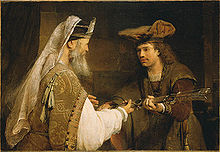 Ahimelech giving the sword of Goliath to David, by Aert de Gelder.
Ahimelech giving the sword of Goliath to David, by Aert de Gelder.
Magic swords may exhibit various degrees of sentience, from being merely influenced by the wielder to being able to think for itself or even control its owner.
Biblical
The Bible relates in the Book of Genesis how God, seeking to deter Adam and Eve from returning to the Garden of Eden, "placed at the east of the garden of Eden Cherubim and a flaming sword which turned every way." By some accounts, the Cherubim are replaced with the Archangel Michael, who wields a similar weapon. King David was given the sword of the slain giant Goliath by the priest Ahimelech, to which was attached extra-biblical mythology and traditions. In the Book of Revelation, Jesus is symbolically described wielding a double-edged sword that proceeds out from his mouth, in reference to the "sword of the spirit" which is the "word of truth".
Mythological
Arthurian
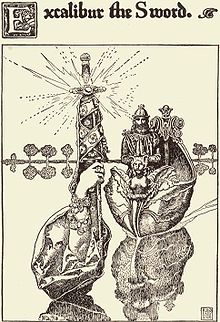 "Excalibur the Sword" Illustration of Arthur receiving it from the Lady of the Lake, by Howard Pyle for The Story of King Arthur and his Knights.
"Excalibur the Sword" Illustration of Arthur receiving it from the Lady of the Lake, by Howard Pyle for The Story of King Arthur and his Knights.
In the legend of King Arthur, the king himself is related to two magical swords, in most variants. The first is the "Sword In the Stone", called Clarent. Only Arthur could draw it out, thereby proving that he is the rightful king. In some tales, this is his only sword. In most variants, this sword was then broken, and he receives from The Lady of the Lake a new sword called Excalibur, arguably the most famous of magic swords. It is not clear from the various accounts of the Arthur legend whether Excalibur itself was possessed of magical powers or merely had a magical origin, though its scabbard protected its bearer from physical harm. Many interpretations of the legend appear to endow the sword with a cutting strength and durability beyond that of ordinary weapons, making it unbreakable by anything but wrongful acts of its user. Excalibur's primary power was apparently spiritual, as it served to identify the chosen king and instill loyalty to him.
Chinese
Ancient Chinese mythology relates the tale of Lü Dongbin, who "slew dragons" with a magic sword and performed "freak feats" with it.[2]
Germanic
In Norse mythology, the god Frey "possessed a magic sword that struck out at Jotuns of its own accord." Many other swords appear in Norse legend in the hands of heroes.
Tyrfing appears in the Hervarar Saga. Svafrlami was the King of Gardariki, and a grandson of the god Odin. He caught the dwarves, Dvalin and Durin, and forced them to forge a sword with a golden hilt that would never miss a stroke, would never rust and would cut through stone and iron as easily as through clothes. The dwarves made the sword, and it shone and gleamed like fire. However, in revenge they cursed it so that it would kill a man every time it was used and that it would be the cause of three great evils. They also cursed it so that it would kill Svafrlami himself. It would cost the life of not only Svafrlami, but also the life of the Swedish hero Hjalmar.
A similar sword to Tyrfing is Dáinsleif, a sword from the legend of the eternal battle Hjaðningavíg, made by the dwarf Dain. Like Tyrfing, Dainsleif gave wounds that never healed and could not be unsheathed without killing a man.
The sword Gram appears in the Völsunga saga. It was stuck by Odin into the tree Barnstokkr in the hall of the Völsungs. Only Sigmund could pull it out. This caused considerable envy and conflict. Eventually, Sigmund fought Odin disguised as an old man, and Odin shattered the sword. Sigmund left it for his son Sigurd, who reforged it to kill Fafnir. There is also Mistilteinn, a sword from the Hrómundar saga Gripssonar, which could never go blunt and which Hrómund won from the undead witch-king Þrainn. Like Tyrfing, it was taken from a barrow-wight.
The legendary smith Wayland Smith forged the magic sword Mimung, which appears both in the Anglo-Saxon poem Waldere and in the German/Scandinavian Þiðrekssaga.
Beowulf wielded the sword Hrunting that was according to the poem annealed in venom. The sword was useless against Grendel's Mother. In desperation Beowulf grabbed a giant sword of great age and with it took off the head of the she monster.
Greek
In Greek mythology, Theseus was given a magic sword with which to kill the Minotaur by Ariadne, the daughter of King Minos.
Japanese
In Japanese mythology, there is a magical sword called Kusanagi, as well as a repeated tradition that the katana of Masamune and Muramasa were of such high quality as to be near-magical. These three swords have been used extensively in popular culture since then, especially in the realm of video game RPGs.
Spanish
More pragmatical, Spanish legends talk too about magical swords. Two belonged to the warrior Rodrigo Díaz de Vivar "El Cid" both with magical powers according to the medieval epical poem "Cantar del mio Cid". The First "Tizona" has personality of its own, with variable strengh according to the man how used it, and even his sight was powerful, as it is stated in the "Cantar del mio Cid":
Él dexó la lança, e mano al espada metió; (He left aside the spear, and took the sword) cuando lo vio Ferrán Gonçález, conuvo [reconoció] a Tizón, (When Ferrán González saw it, he recognized Tizón) antes qu'el colpe esperasse dixo: —¡Vençudo só!— (And before the first strike, he said: I am lost) Cantar de mio Cid, versos 3642–3645. Edición de Montaner Frutos (2011:213-214).
The same is the case for "Colada" which was powerful only in the hands of a brave warrior.
Other
In the Matter of France, Roland possessed an indestructible sword, Durendal, which he threw into a poisoned stream to prevent its capture. In the same legends, Charlemagne owned a notable sword, Joyeuse, while Bishop Turpin wielded Almace.
Fiction
Edmund Spenser's The Faerie Queene features a golden sword called Chrysaor, the personal weapon of Sir Artegal, the Knight of Justice. The sword was given to him by Astræa, who had been holding it since the days when Zeus had used it to battle the Titans. Because it was "Tempred [ sic ] with Adamant", it was described as being able to cleave through anything.
In Der Ring des Nibelungen, Richard Wagner drew on the legends of Grimm for the sword Nothung, belonging to the hero Siegmund and later reforged by his son Siegfried and used by him to kill Fafner.
The hero of Lewis Carroll's poem "Jabberwocky" slays the Jabberwock with a vorpal sword. Although the poem does not define the word "vorpal" (and contains many nonsensical words with no meaning), the term has been adopted in role playing games to describe a sword which possesses a magical ability to decapitate those against whom it is wielded.
In the works of J. R. R. Tolkien such as The Lord of the Rings, many magical swords, usually with powers for good, are wielded by important characters. Gandalf uses his sword Glamdring in his battle with the Balrog, who wields its own sword of flame. Glamdring's sister blade, Orcrist, is buried with Thorin Oakenshield under the Lonely Mountain in The Hobbit. Bilbo, Frodo and Samwise carry the sword Sting. It and Glamdring both glow blue when orcs are near. Aragorn bears the sword Andúril, a potent weapon against the evil of Mordor and a symbol of his right to rule. In addition, in Farmer Giles of Ham, the protagonist is given and wields a magic sword named Caudimordax which, in the story, is translated to mean "Tailbiter".
Hal Foster's Prince Valiant wields the Singing Sword, which makes its bearer undefeatable if he fights for a good cause.
In Margaret Weis and Tracy Hickman's Darksword series the Darksword is a sword capable of absorbing magic.
Michael Moorcock created a sinister magic sword in Stormbringer, wielded by Elric of Melniboné. This black sword has the power to suck out the souls of its victims and transfer their energy to its holder. It also appears to have a mind of its own, sometimes striking against its "master's" will. Mercedes Lackey's creation, the sword Need is similarly independent, although along less sinister lines.
The Twelve Swords of Power are the primary plot device in Fred Saberhagen's Books of the Swords.
Lawrence Watt-Evans's The Misenchanted Sword (1985) involves the difficulties of dealing with the sword of the title; the protagonist must kill a man when he draws it, can only kill one, will die if he ever kills a hundred men with it – and will not die without killing them, but will ceaselessly age.
The Blue Sword contains a blue sword, known as Gonturan, that is both a symbol of power (as it can only be used by a damalur-sol, a woman hero), an amplifier of magic and a very sharp sword. It is also a sword with a mind of its own.
In Robert Jordan's The Wheel of Time is the sword Callandor, which is actually not a sword, but a powerful Sa'angreal shaped as a sword and made out of crystal. It is kept within the Stone of Tear. It can only be taken by the Dragon and is a major sign of his return. Until he takes it the Stone of Tear will never fall to any invaders, but when the sword is taken the Stone is said to fall to the People of the Dragon. It is later revealed that unlike other Sa'angreals it doesn't have the safety mechanism that prevents a wielder from absorbing too much of the One Power through it.
Terry Goodkind's series is named for its magical weapon, the Sword of Truth. This blade, with the word "Truth" inlaid into the handle, factors into many of the moral decisions made by Richard Rahl, the series' protagonist. The blade, like most magic in the series, is focused on need. The sword's master is referred to as the Seeker of Truth. The Seeker gains the swordmastery of all those that have wielded the blade previously. Many false Seekers have carried the sword, but a true Seeker can only be named by the First Wizard (Rahl is named by his grandfather, Zeddicus Zorander). A true Seeker has the ability to turn the blade white when he kills in compassion and forgiveness. Richard has done this twice. Once, killing the Mord-Sith which captured him in Wizard's First Rule, and again to kill a Sister of the Dark in Stone of Tears.
The eponymous sword from The Sword of Shannara series, by Terry Brooks, has a distinctive pommel in the form of the druidic symbol from the series: a hand holding aloft a torch (similar to the Statue of Liberty). Otherwise it is visually unremarkable, though very well made and unworn. Its ability lies in revealing absolute truth, which can be difficult to bear. The sentiment of the enchantment follows that of the "To thine own self be true..." advice to Laertes. A prospective wielder, upon drawing the blade for the first time, is made to confront all their personal flaws, shortcomings, fears, delusions and morally questionable acts. If the being's psyche cannot deal with the revelations, they might not be permanently harmed, but the blade is unusable to them. However, if they can accept the truth of themselves, though it is still a jarring experience, they come out of it wiser for the self-knowledge. Also, they are able to wield the Sword as both a particularly strong and sharp weapon, and as a harsh mirror of Truth to those touched by the blade. This exposure to reality, like many years of counseling condensed into a moment, can actually destroy anyone "evil" enough, e.g. the Warlock Lord of the same book. It also can reveal illusions and give some protection from magical effects.
Also of note is the Sword Nightblood from the book Warbreaker [2009]. Nightblood is a sentient sword which was given a direction when awakened. This direction was to 'destroy evil.' However, being a sword, Nightblood could not judge right and wrong and killed almost indiscriminately. Simply undoing the clasp (which was extraordinarily tempting for one without a pure heart) was enough for nightblood to utterly destroy the one holding it. Nightblood was often recovered by Vasher sticking clean through a man, not even unsheathed. Nightblood, when fully drawn consumed Its user's BioChromatic breaths at an alarming rate, while sending tendrils of darkness out to destroy anything the sword deemed 'evil.' The sword could also telepathically communicate with its wielder, often asking questions such as "Hello, would you like to kill someone today?" or alternatively asking to be unsheathed.
The Harry Potter series of novels by J.K. Rowling features the Sword of Gryffindor, which is used by several of the book's prominent characters. The sword is an indestructible weapon crafted from goblin metal, the properties of which allow the sword to absorb any substance into itself that will make it stronger, in the case of the books, the immensely deadly venom of a basilisk.
Movies and television
In the Star Wars saga, which employs many themes of classical mythology, the lightsaber can be seen as a science fiction or science fantasy analogue of the magic swords of myth. The device appears to defy the laws of physics, bringing to mind Arthur C. Clarke's third law of prediction, the observation that a technology that is sufficiently advanced would be indistinguishable from magic. Within the Star Wars universe, lightsabers are made by their wielder as part of the training to become a Jedi knight.
In the movie The Golden Blade (1952), the Sword of Damaskus, which can cut anything and makes its wielder invincible, is used by Harun Al-Rashid (Rock Hudson) to free a fairy-tale Baghdad from Jafar, a usurper of the throne.
The He-Man cartoon series more directly mixes magic and technology, with the titular hero deriving his power from a magic sword but living in a world where the traditional gadgetry of science fiction is as common as magic.
In the British television series Robin of Sherwood, Robin Hood carries Albion, one of the seven swords of Wayland. The sword's powers include providing visions to its bearer. It cannot hurt its master.
The Sword of Omens in the Thundercats animated series possesses magical powers and the Eye of Thundera in the hilt. Another sword, the Sword of Plun-Darr, was a key element to the plot of certain episodes.
In the Samurai Jack animated series, the father of the titular hero gave his son a katana from the gods to defeat the evil Aku. Only this magic katana could harm Aku, although it could not kill him completely. This magic sword would obey only its rightful owner, making it impossible to hurt Jack when his enemy wields it. The sword was forged of the pure spirit of good that humans possess, extracted from Jack's father.
In the animated series "Thundarr the Barbarian" the main character Thundarr wields the lightsaber-like sun sword.
In the South Park episode "Make Love, Not Warcraft", the story contains a powerful sword referred to as "The Sword of A Thousand Truths"; a direct reference to the World of Warcraft Sword "Frostmourne"; used by the Lich King.
Anime
- The manga and subsequent anime Bleach features several magic swords, called zanpakuto ("soul-cutting swords"). These katana-like weapons are assigned to specific Shinigami (called "Soul Reapers" in the English translation) within the Bleach universe as their own personal property. A zanpakuto can grow in strength and power in tandem with its user. These swords are often personified in humanoid form throughout the series. All zanpakuto have unique and often poetic Japanese names such as Ichigo Kurosaki's zanpakuto is called Zangetsu, which means Moon-Cutter.
- In Rave Master, Haru's sword, "Decaforce Sword" is a kind of magic sword powered by Rave stones. It is used by Haru to destroy Dark stones.
- In Naruto, another Japanese manga series, based heavily on traditional folklore themes, the legendary grasscutter kusanagi-no tsurugi makes an entrance. The sword used to be in the possession of the snake sannin Orochimaru as the poisonous blade complements the ninja's affinity to summoned snakes. Its counterpart is said to be the sword Totsuka, a sword wielded by the god Susanoo, capable of sealing everything it touches into a pure state of peaceful entrapment.
- Gourry Gabriev of the anime and manga The Slayers is a knight who wields the Sword of Light, a sword with a magical blade of pure light.
- In YuYu Hakusho, Kuwabara Kazuma wields his "spirit power" as a "spirit sword," a lightsaber-like energy blade coming from a wooden handle made from a broken wooden sword tip. His power was later enhanced by a magical handle.
- In the various Tenchi Muyo! media, the main character, Tenchi Masaki, gains the power of a legendary lightsaber-like weapon that accompanies a pair of energy wings that are his inherent power. Another character, Ryoko, has the ability to create a red energy blade.
- In the manga and anime videos Ogre Slayer, the main character has no name and is known by the name of his sword, Onikirimaru or ogre-slayer. The sword enables him to track and kill ogres.
- In InuYasha both the titular character InuYasha and his half brother Sesshomaru wield magical blades created by their father's fangs, and there are many other magical swords and weapons in the series mostly gaining power from the energy of the wielder.
- In the anime and manga Reborn! the 10th Vongola Rain Guardian Takeshi Yamamoto and Varia Rain Guardian Superbi Squalo use a swords. Yamamoto uses Shigure Kintoki which was given to him by his father. Squalo uses Arm-Mounted Sword.
Video and role-playing games
Video games and fantasy role-playing games feature a great variety of magical armaments, most commonly represented by swords and similar archetypal weapons. These swords are rarely unique, and in many role-playing scenarios, magical weapons are so ubiquitous that the player characters are expected to come into possession of them as a matter of course.
- The Legacy of Kain series features a powerful blade called Soul Reaver, which is used to devour souls of its victims.
- In the Soul series, the plot focuses on two magic weapons: an evil, soul-devouring sword named Soul Edge and its holy counterpart, Soulcalibur.
- The Legend of Zelda games features many magic swords such as the Master Sword and the Picori Blade, which gains power and transforms into the Four Sword as well as the magic sword itself. In The Legend of Zelda: Phantom Hourglass the ultimate weapon is the Phantom Sword.
- The 'Blades of Chaos' are a pair of divine blades forged in the fire of hades in God of War. The series also contains the Blade of Artemis and the Blade of Olympus. Both are divine weapons used by gods to defeat the Titans in the Titanomachy.
- In the Prince of Persia trilogy, there is a blade called the Dagger of Time, which gives its wielder many time-based powers.
- In Riviera: The Promised Land, the lead character, Ein, wields a sword called the Einherjar, in exchange of losing his wings. The sword is called by other in-game characters as a Diviner, or a weapon owned by Grim Angels, capable of vanquishing demons.
- The Ultima series features many magical swords, the most notable and powerful being the Black Sword, which contains the powers of a demon.
- In Grand Chase, the weapon of Ronan's 4th job is called Tyrfing. Named after the Norse Mythology sword Tyrfing.
- In Warcraft III, Frostmourne is the Lich King's sword used to steal Prince Arthas' soul.
See also
- List of magical weapons
- Magic item
- Sentient weapon
References
- ^ a b Josepha Sherman, Once upon a Galaxy p 113 ISBN 0-87483-387-6
- ^ Eight Immortals in Chinese Mythology
Categories:- Fictional swords
- Fantasy tropes
- Mythological swords
Wikimedia Foundation. 2010.

